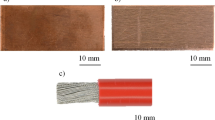Abstract
In this paper the microscopical structure of wedge bonded interfaces is investigated, with a focus on what effect the power in the ultrasonic bonding and the initial microscopical structure of the \(Al\) wire have on the quality of the bonding. The quality evaluation is based on mapping the microscopical restructuring of the wire grains during bonding and thereby assessing the effective bonding area. Three approaches are utilized in the interface characterization: mechanical shear test, optical microscopy combined with micro-sectioning, and scanning electron microscopy assisted by focused ion beam milling. The shear test is applied to quantify the strength of the bonded interfaces, while the other methods are used to map the grain reconstruction caused by the bonding. From the results it is possible to map a 3D image of the wire deformation, and the grain refinement region which is the dominating parameter with respect to fatigue related cracking of the interfaces. It is found that the bonding power, as well as the initial wire structure directly affects the refinement region and thereby the strength of the interface.







Similar content being viewed by others
References
P. Agyakwa, M. Corfield, L. Yang, J. Li, V. Marques, C. Johnson, Microstructural evolution of ultrasonically bonded high purity Al wire during extended range thermal cycling. Microelectron. Reliab. 51, 406–415 (2011)
M. Ciappa, P. Malberti, W. Fichtner, P. Cova, L. Cattani, F. Fantini, Lifetime extrapolation for IGBT modules under realistic operation conditions. Microelectron. Reliab. 39, 1131–1136 (1999)
B. Czerny, M. Lederer, B. Nagl, A. Trnka, G. Khatibi, M. Thoben, Thermo-mechanical analysis of bonding wires in IGBT modules under operating conditions. Microelectron. Reliab. 52, 2353–2357 (2012)
B. Czerny, I. Paul, G. Khatibi, M. Thoben, Experimental and analytical study of geometry effects on the fatigue life of Al bond wire interconnects. Microelectron. Reliab. 53, 1558–1562 (2013)
P. Dietrich, Trends in automotive power semiconductor packaging. Microelectron. Reliab. 53, 1681–1686 (2013)
U. Geissler, M. Schneider-Ramelow, H. Reichl, Hardening and softening in AlSi1 bond contacts during ultrasonic wire bonding. IEEE Trans. Compon. Packaging Manuf. Technol. 32, 794–799 (2009)
J. Goehre, M. Schneider-Ramelov, U. Geissler, K. Lang, Interface degradation of Al heavy wire bonds on power semiconductors during active power cycling measured by the shear test, in Conference on Integrated Power Electronics Systems, 3.4 (2010)
N. Hansen, Hall–Petch relation and boundary strengthening. Scr. Mater. 51, 801–806 (2004)
G. Harman, J. Albers, The ultrasonic welding mechanism as applied to aluminium- and gold-wire bonding in microelectronics. IEEE Trans Parts Hybrids Packaging 13(4), 406–412 (1977)
W. Kanert, Active cycling reliability of power devices: expectations and limitations. Microelectron. Reliab. 52, 2336–2341 (2012)
J. Krzanowski, A transmission electron microscopy study of ultrasonic wire bonding. IEEE Trans. Compon. Hybrids Manuf. Technol. 13, 176–181 (1990)
B. Langenecker, Effects of ultrasound on deformation characteristics of metals. IEEE Trans. Sonics Ultrason. 13(1), 1–8 (1966)
I. Lum, M. Mayer, Y. Zhou, Footprint study of ultrasonic wedge-bonding with aluminum wire on copper substrate. J. Electron. Mater. 35, 433–442 (2006)
K. Pedersen, P. Kristensen, V. Popok, K. Pedersen, Micro-sectioning approach for quality and reliability assessment of wire bonding interfaces in IGBT modules. Microelectron. Reliab. 53, 1422–1426 (2013)
S. Ramminger, P. Trkes, G. Wachutka, Crack mechanism in wire bonding joints. Microelectron. Reliab. 38, 1301–1305 (1998)
U. Scheuermann, R. Schmidt, Impact of load pulse duration on power cycling lifetime of al wire bonds. Microelectron. Reliab. 53, 16871691 (2013)
A. Volke, M. Hornkamp, in IGBT Modules—Technologies, Driver and Application (Infineon Technologies, 2011). ISBN 978-3-00-032076-7
G.V. Voort, ASM Handbook: Volume 9: Metallography And Microstructures (ASM International, Metals Park, 2004)
Acknowledgments
The work is a part of the Center of Reliable Power Electronics (CORPE) funded by the Danish Strategic Research Council. A special thanks is attributed to Kim Houtved Jensen and Dorthe Rasmussen for assistance with sample preparation.
Author information
Authors and Affiliations
Corresponding author
Rights and permissions
About this article
Cite this article
Pedersen, K.B., Benning, D., Kristensen, P.K. et al. Interface structure and strength of ultrasonically wedge bonded heavy aluminium wires in Si-based power modules. J Mater Sci: Mater Electron 25, 2863–2871 (2014). https://doi.org/10.1007/s10854-014-1953-8
Received:
Accepted:
Published:
Issue Date:
DOI: https://doi.org/10.1007/s10854-014-1953-8




